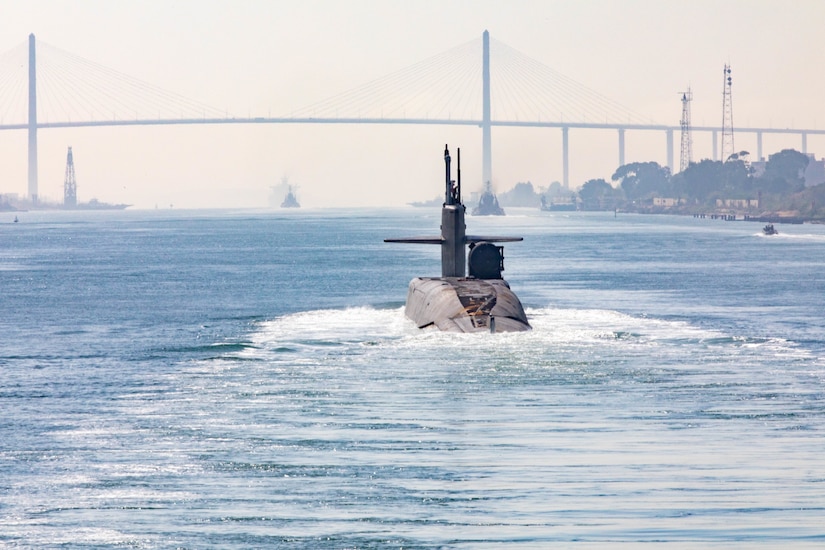In a nuclear conflict where adversaries launch a first strike, it’s possible they might render U.S. ground-based and air-launched systems unusable. But the U.S. still maintains deterrence though sea-based systems, which guarantee a second-strike capability— the ability to strike back.
“If you think about it from the adversary’s perspective, anything that they may think they could do as an initial strike, that [ballistic missile submarine] force is always out there on alert, on patrol, unknown where they’re at,” said Navy Vice Adm. Johnny R. Wolfe Jr., director for strategic systems. “Certainly, if ever called upon, they are survivable and could ensure that a second-strike from our nation could be performed. That is absolutely critical, as you look at deterrence and what it means.”
Wolfe, along with Air Force Gen. Thomas A. Bussiere, commander of Air Force Global Strike Command, testified Wednesday before the Senate Armed Services strategic forces subcommittee.
Since last year there have been some advancements on the Navy’s efforts to modernize its own portion of the U.S. nuclear triad.
“We have built on this remarkable history of deterrence, marking such milestones as the final demonstration and shakedown operation for our Ohio-class ballistic missile submarines [and] establishment of a new nuclear office for the sea-launched cruise missile, SLCM-N,” Wolfe said. “Additionally, in coordination with our [National Nuclear Security Administration] partners, we are initiating a nuclear weapon project to adapt a nuclear warhead for this new capability.”
The sea-launched cruise missile, nuclear, or SLCM-N, can be launched from surface ships and also attack subs, rather than from traditional ballistic missile submarines. Wolfe told senators that the industrial base that would be most responsible for building the SLCM-N has atrophied and that it’ll be a challenge to build it back.
“Significant investments are required to build back capacity to handle multiple concurrent nuclear modernization programs,” he told senators.
The admiral also stressed to lawmakers that despite challenges such as an atrophied industrial base and supply chain challenges, the Navy must advance modernization of its part of the nuclear triad.
“First and foremost, we must maintain the current [Trident II D5LE] missile inventory and provide the necessary operational support to sustain Ohio-class submarines through the end of their life in the early 2040s,” he said. “Secondly … we must continue to ensure a seamless transition between Ohio-class and Columbia-class submarines.”
The Columbia-class ballistic missile submarine is a replacement for the Ohio-class SSBN, which first saw duty in the 1980s. Part of that, Wolfe said, is transitioning the Trident II D5LE from the Ohio-class subs to the Columbia-class subs.
Wolfe also said that the U.S. isn’t alone in providing nuclear capability as a deterrent. He cited the British as a significant partner in that endeavor.
“One of the greatest advantages the United States has is its alliances and partnerships,” he said. “For decades, U.S. policy has recognized the contribution … an independent British nuclear deterrent adds to NATO, and indeed global stability. [Strategic Systems Programs] will continue to support and sustain this most-important relationship.”
The admiral said nuclear modernization will take time and will require investments in people, infrastructure and the U.S. industrial base.
“It is only through your continued support that the department’s highest modernization priorities can be achieved, and the Navy can deliver a reliable sea-based strategic deterrent capability,” he said.
While the Navy operates one leg of the nuclear triad, the Air Force operates two legs, with both land-based siloed nuclear missiles and air-launched missiles.
“The timely modernization of our nuclear triad … remains the command’s paramount focus,” said Bussiere.
Ongoing modernization efforts are aimed at GSC’s land-based intercontinental ballistic missiles, bomber force, nuclear command and control platforms, weapons generation facilities and associated nuclear weapons, Bussiere said.
“This committee is keenly aware of the threats facing our nation today and in the foreseeable future,” he said. “We currently face the challenge of deterring two major nuclear armed competitors, the People’s Republic of China and the Russian Federation, both armed with modern and diverse nuclear capabilities.”
Also a threat, he said, are North Korea and Iran.
“Not only is the command leading the charge and sustaining current forces and deploying future long-range strike weapon systems, Global Strike Command is acutely aware that the nuclear deterrence mission is the bedrock of our national defense strategy, and foundational to our nation’s defense and essential to that of our allies and partners,” Bussiere said.
The DOD’s fiscal year 2025 budget request includes $49.2 billion to modernize the department’s nuclear triad. Included in the request are investments for the Columbia-class ballistic missile submarine, the B-21 bomber and the Sentinel system, which is a modernization for the ground-based portion of the nuclear triad.









